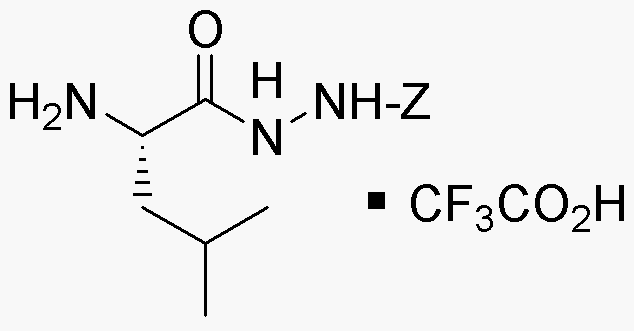Leucine benzyloxycarbonylhydrazide trifluoroacetate is widely utilized in research focused on:
- Peptide Synthesis: This compound serves as a key building block in the synthesis of peptides, particularly in the pharmaceutical industry where custom peptides are needed for drug development.
- Biochemical Research: It is used in studies involving protein interactions and enzyme activity, helping researchers understand biological processes at a molecular level.
- Drug Development: The compound plays a role in the design of novel therapeutics, particularly in targeting specific pathways in diseases such as cancer and metabolic disorders.
- Analytical Chemistry: It aids in the development of analytical methods for the detection and quantification of amino acids and peptides, enhancing the accuracy of biochemical assays.
- Academic Research: Universities and research institutions utilize this compound for educational purposes, allowing students to explore advanced concepts in organic and medicinal chemistry.
General Information
Properties
Safety and Regulations
Applications
Leucine benzyloxycarbonylhydrazide trifluoroacetate is widely utilized in research focused on:
- Peptide Synthesis: This compound serves as a key building block in the synthesis of peptides, particularly in the pharmaceutical industry where custom peptides are needed for drug development.
- Biochemical Research: It is used in studies involving protein interactions and enzyme activity, helping researchers understand biological processes at a molecular level.
- Drug Development: The compound plays a role in the design of novel therapeutics, particularly in targeting specific pathways in diseases such as cancer and metabolic disorders.
- Analytical Chemistry: It aids in the development of analytical methods for the detection and quantification of amino acids and peptides, enhancing the accuracy of biochemical assays.
- Academic Research: Universities and research institutions utilize this compound for educational purposes, allowing students to explore advanced concepts in organic and medicinal chemistry.
Documents
Safety Data Sheets (SDS)
The SDS provides comprehensive safety information on handling, storage, and disposal of the product.
Product Specification (PS)
The PS provides a comprehensive breakdown of the product’s properties, including chemical composition, physical state, purity, and storage requirements. It also details acceptable quality ranges and the product's intended applications.
Certificates of Analysis (COA)
Search for Certificates of Analysis (COA) by entering the products Lot Number. Lot and Batch Numbers can be found on a product’s label following the words ‘Lot’ or ‘Batch’.
Numéro de catalogue
Numéro de lot/série
Certificates Of Origin (COO)
This COO confirms the country where the product was manufactured, and also details the materials and components used in it and whether it is derived from natural, synthetic, or other specific sources. This certificate may be required for customs, trade, and regulatory compliance.
Numéro de catalogue
Numéro de lot/série
Safety Data Sheets (SDS)
The SDS provides comprehensive safety information on handling, storage, and disposal of the product.
DownloadProduct Specification (PS)
The PS provides a comprehensive breakdown of the product’s properties, including chemical composition, physical state, purity, and storage requirements. It also details acceptable quality ranges and the product's intended applications.
DownloadCertificates of Analysis (COA)
Search for Certificates of Analysis (COA) by entering the products Lot Number. Lot and Batch Numbers can be found on a product’s label following the words ‘Lot’ or ‘Batch’.
Numéro de catalogue
Numéro de lot/série
Certificates Of Origin (COO)
This COO confirms the country where the product was manufactured, and also details the materials and components used in it and whether it is derived from natural, synthetic, or other specific sources. This certificate may be required for customs, trade, and regulatory compliance.


